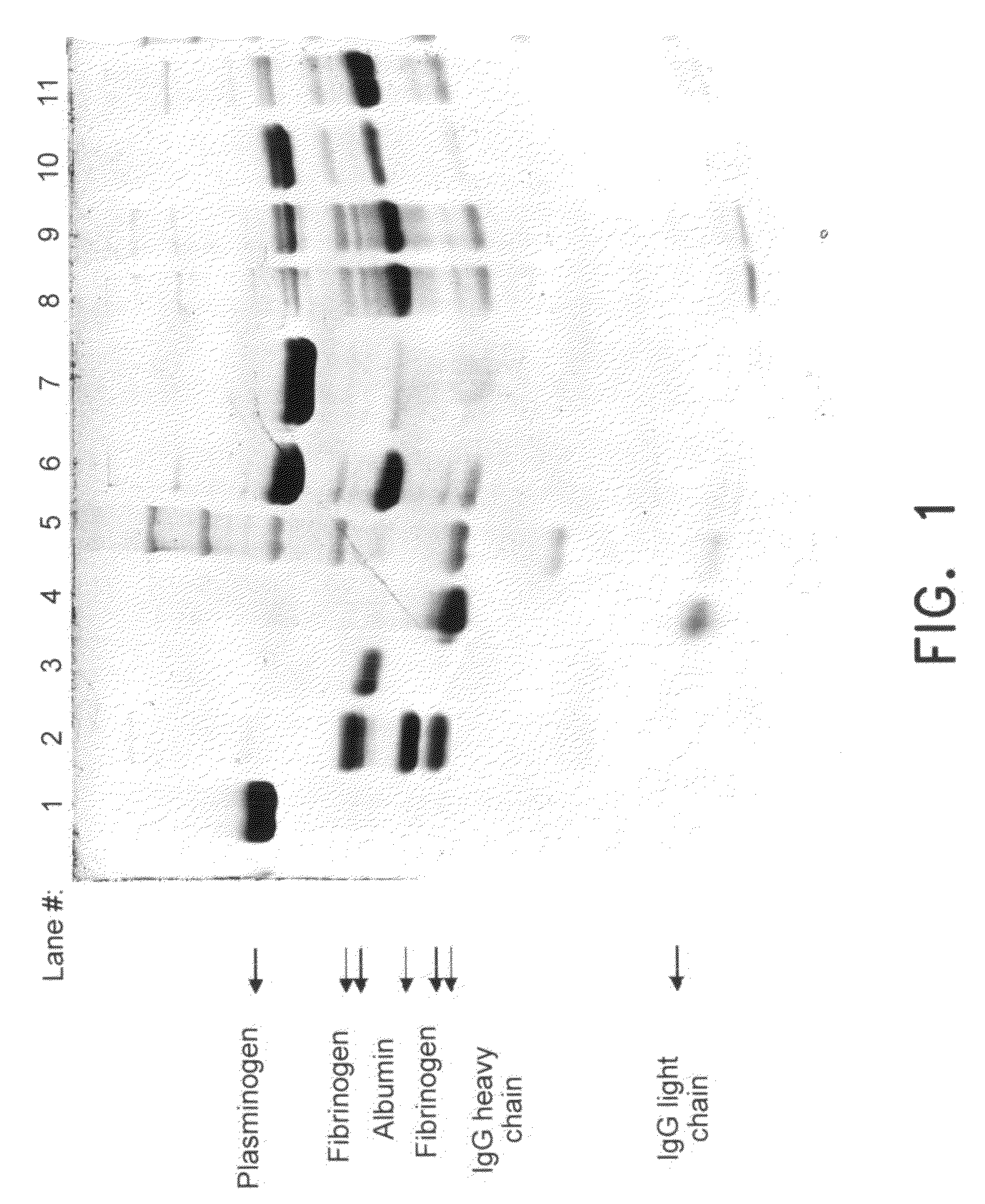Removal of plasmin(ogen) from protein solutions
a technology of plasmin and protein solution, which is applied in the field of removal of plasmin (ogen) from protein solution, can solve the problems of low antifibrinolytic potency of lysine, totally distorted protein solution composition,
- Summary
- Abstract
- Description
- Claims
- Application Information
AI Technical Summary
Problems solved by technology
Method used
Image
Examples
example 1
Immobilization of Various ε-Amino-Carboxylic Acid Ligands
[0045]A series of ε-amino-carboxylic acid ligands in combination with various spacers in several resins were either produced or purchased (if commercially available) to evaluate the plasmin(ogen) removal from plasma derived solutions. The following table summarizes all the combinations studied (the numbers below the resins relate to the section where the synthesis for each combination is described below):
TABLE 1LigandP-Tranexamicε-AminohexanoicLinkerbenzamidineArginineacidacidLysineN-hydroxy-Sepharose 4Bsuccinic(1)DADPAAgarose 4%Agarose 4%Agarose 4%(2)(3)(4)CNBrSepharose 4BSepharose 4B(5)(6)EpoxySepharoseSepharose 6BSepharose 6BCeramic6B (10)(7)(8)HyperDF(9)(1) ε-aminohexanoic acid N-hydroxysuccinimide ester Sepharose 4B was purchased from Sigma.(2) Manufacturing of p-aminobenzamidine- Agarose 4%The following procedure was used for the immobilization of Diaminodipropylamine (DADPA) on Agarose 4% (Pierce), the reaction took pla...
example 2
Screening of the Different Affinity Chromatography Resins for Plasmin(ogen) Removal
[0046]Human plasma pooled cryoprecipitate containing 1 IU / ml of plasmin(ogen) and 50 mg / ml fibrinogen was used for the following study.
[0047]Aliquots of frozen cryoprecipitate were thawed at 37° C. and dialyzed against buffer BN1 (0.12 M NaCl, 10 mM Tri Na-citrate, 1 mM CaCl2 at pH 7.0). This protein solution was filtered through a 5 μm depth filter to obtain a clear solution. A 5 ml syringe cylinder with a diameter of 8.36 mm was packed with 1.5 ml (wet volume) of the following affinity resins described in example 1: immobilized ε-aminohexanoic acid (Sepharose 4B using CNBr as a spacer), immobilized p-aminobenzamidine / Arginine / TEA (Agarose 4% using DADPA as a spacer), immobilized Arginine / TEA (Sepharose 4B using CNBr as a spacer), immobilized Arginine / TEA (Sepharose 6B using epoxy as a spacer) and immobilized L-Lysine (Ceramic HyperDF Hydrogel using epoxy as a spacer). The optimized gel packing proce...
example 3
Effect of Buffer Phosphate and BNI on the Affinity Chromatography Profile of Lysine and TEA-Immobilized Resin
[0055]Cryoprecipitate was treated with aluminium hydroxide to adsorb the Vitamin K dependent clotting factors, and then incubated with a solvent detergent mixture (SD-1% Tri(n-butyl)phosphate, 1% Triton X-100) for 4 hours at 30° C. to inactivate lipid enveloped viruses. The SD reagents were removed by castor oil extraction and hydrophobic interaction chromatography, and the preparation was subsequently pasteurized (10 h at 60° C.) in the presence of sucrose and glycine as stabilizers.
[0056]After pasteurisation, the sucrose and glycine were removed by diafiltration. Tranexamic acid (TEA) and Arginine hydrochloride were added as stabilizers prior to sterile filtration. Aliquots of the stabilized product was kept at −30° C. until used.
[0057]Aliquots of frozen, virus inactivated cryoprecipitate were thawed at 37° C. and dialyzed against buffer BN1 (composed of 0.12 M NaCl, 0.01 M...
PUM
| Property | Measurement | Unit |
|---|---|---|
| distance | aaaaa | aaaaa |
| distance | aaaaa | aaaaa |
| pH | aaaaa | aaaaa |
Abstract
Description
Claims
Application Information
 Login to view more
Login to view more - R&D Engineer
- R&D Manager
- IP Professional
- Industry Leading Data Capabilities
- Powerful AI technology
- Patent DNA Extraction
Browse by: Latest US Patents, China's latest patents, Technical Efficacy Thesaurus, Application Domain, Technology Topic.
© 2024 PatSnap. All rights reserved.Legal|Privacy policy|Modern Slavery Act Transparency Statement|Sitemap


